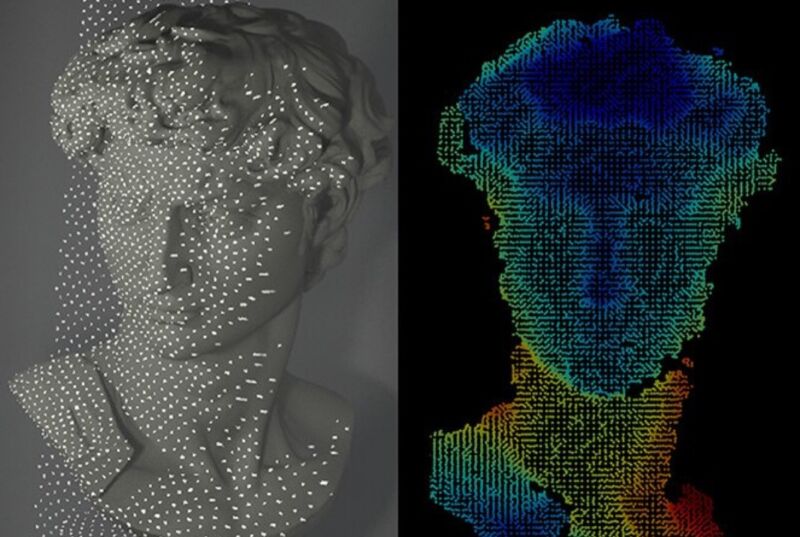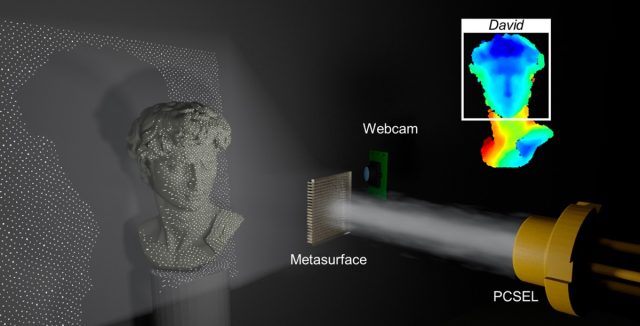A face for the ages —
Flatter, simpler prototype system uses 5-10 times less power than smartphone tech.

Enlarge / A new lens-free and compact system for facial recognition scans a bust of Michelangelo’s David and reconstructs the image using less power than existing 3D-surface imaging systems.
W-C Hsu et al., Nano Letters, 2024
Facial recognition is a common feature for unlocking smartphones and gaming systems, among other uses. But the technology currently relies upon bulky projectors and lenses, hindering its broader application. Scientists have now developed a new facial recognition system that employs flatter, simpler optics that also requires less energy, according to a recent paper published in the journal Nano Letters. The team tested their prototype system with a 3D replica of Michelangelo’s famous David sculpture, and found it recognized the face as well as existing smartphone facial recognition.
The current commercial 3D imaging systems in smartphones (like Apple’s iPhone) extract depth information via structured light. A dot projector uses a laser to project a pseudorandom beam pattern onto the face of the person looking at a locked screen. It does so thanks to several other built-in components: a collimator, light guide, and special lenses (known as diffractive optical elements, or DOEs) that break the laser beam apart into an array of some 32,000 infrared dots. The camera can then interpret that projected beam pattern to confirm the person’s identity.
Packing in all those optical components like lasers makes commercial dot projectors rather bulky, so it can be harder to integrate for some applications such as robotics and augmented reality, as well as the next generation of facial recognition technology. They also consume significant power. So Wen-Chen Hsu, of National Yang Ming Chiao Tung University and the Hon Hai Research Institute in Taiwan, and colleagues turned to ultrathin optical components known as metasurfaces for a potential solution. These metasurfaces can replace bulkier components for modulating light and have proven popular for depth sensors, endoscopes, tomography. and augmented reality systems, among other emerging applications.

Enlarge / Schematic of a new facial recognition system using a camera and meta surface-enhanced dot projector.
W-C Hsu et al., Nanoletters, 2024
Hsu et al. built their own depth-sensing facial recognition system incorporating a metasurface hologram in place of the diffractive optical element. They replaced the standard vertical-cavity surface-emitting laser (VCSEL) with a photonic crystal surface-emitting laser (PCSEL). (The structure of photonic crystals is the mechanism behind the bright iridescent colors in butterfly wings or beetle shells.) The PCSEL can generate its own highly collimated light beam, so there was no need for the bulky light guide or collimation lenses needed in VCSEL-based dot projector systems.
The team tested their new system on a replica bust of David, and it worked as well as existing smartphone facial recognition, based on comparing the infrared dot patterns to online photos of the statue. They found that their system generated nearly one and a half times more infrared dots (some 45,700) than the standard commercial technology from a device that is 233 times smaller in terms of surface area than the standard dot projector. “It is a compact and cost-effective system, that can be integrated into a single chip using the flip-chip process of PCSEL,” the authors wrote. Additionally, “The metasurface enables the generation of customizable and versatile light patterns, expanding the system’s applicability.” It’s more energy-efficient to boot.
Nano Letters, 2024. DOI: 10.1021/acs.nanolett.3c05002 (About DOIs).
Listing image by W-C Hsu et al., Nano Letters, 2024